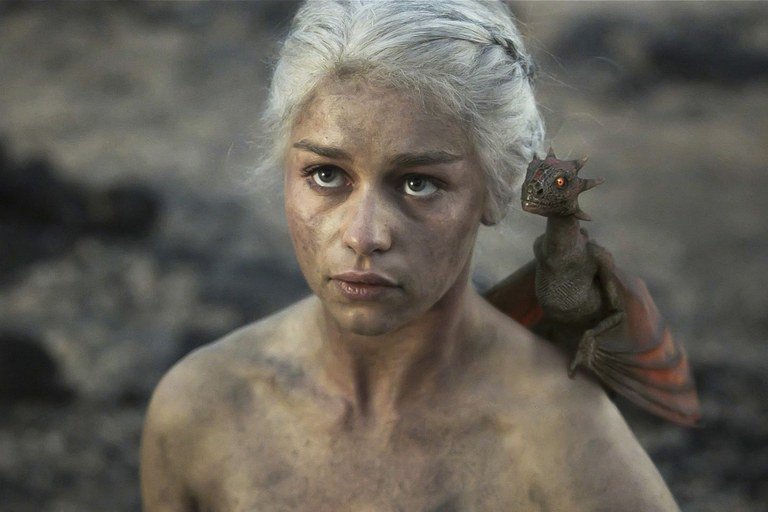Actor Emilia Clarke, most famously known for her role of Daenerys Targaryen in the HBO series Game Of Thrones, is brilliant at what she does. Whether it’s raising dragons or commanding Dothraki, we can’t imagine anyone being a Khaleesi other than Emilia.

And yet, for the Mother of Dragons who we’ve grown to love and cheer for, the GOT journey could have ended a long time back – right after her first season in fact.
In an exclusive piece with The New Yorker, Emilia Clarke revealed how she battled with not one, but two brain aneurysms, while shooting for the initial seasons of Game of Thrones.

Emilia talked about being cast as Daenerys in the show, her first audition, the success of season 1, and the aneurysm(s) that followed.
Season 1 was slated to release in April 2011. In February 2011, Emilia suffered from an aneurysm during her workout. She had experienced an arterial rupture, causing subarachnoid hemorrhage (SAH) – a life-threatening type of stroke.

She was immediately brought to the hospital, where an MRI scan revealed the need for urgent surgery. And yet, through blinding pain, she kept thinking of how, she didn’t have time for a surgery with so much at stake.
My mum slept in my hospital ward, slumped in a chair, as I kept falling in and out of sleep, in a state of drugged wooziness, shooting pain, and persistent nightmares. For the next three hours, surgeons went about repairing my brain. This would not be my last surgery, and it would not be the worst. I was twenty-four years old.

However, for Emilia – who’d wanted to be an actor for as long she could remember – the worst was yet to come. As a result of the surgery, she suffered from a condition called aphasia where her cognitive functions were compromised. Simply put, she couldn’t remember her own name.
I’d never experienced fear like that—a sense of doom closing in. I could see my life ahead, and it wasn’t worth living. I am an actor; I need to remember my lines. Now I couldn’t recall my name. In my worst moments, I wanted to pull the plug. I asked the medical staff to let me die. My job—my entire dream of what my life would be—centered on language, on communication. Without that, I was lost.

After another long week in the I.C.U. Emilia finally recovered, with her cognitive functions intact and the stark realization that she was ‘more fortunate’ than so many people around.
After about a week, the aphasia passed. I was able to speak. I knew my name—all five bits. One month after being admitted, I left the hospital, longing for a bath and fresh air. I had press interviews to do and, in a matter of weeks, I was scheduled to be back on the set of “Game of Thrones.”

Throughout promotions, shooting for upcoming seasons, multiple comic-cons, and press interviews, Emilia battled not just weakness and pressure, but also the knowledge that there still was a smaller aneurysm on the other side of her brain.

She sipped on morphine between interview breaks, constantly battled fatigue, and had to undergo regular scans to ensure that the show went on. And in one such scan in 2013 – after finishing season 3- it was revealed that she’d need surgery again, as her aneurysm had grown double in size.

This time she went in with the knowledge that it’ll be a relatively simple procedure – but it failed. She came out in more pain that she’d ever experienced and in need of immediate and more extensive surgery.
Bits of my skull had been replaced by titanium. These days, you can’t see the scar that curves from my scalp to my ear, but I didn’t know at first that it wouldn’t be visible. And there was, above all, the constant worry about cognitive or sensory losses. Would it be concentration? Memory? Peripheral vision? Now I tell people that what it robbed me of is good taste in men. But, of course, none of this seemed remotely funny at the time.

After a month-long recovery, that included fighting panic attacks, anxiety, and losing hope, Emilia made it through, but with the knowledge that she didn’t want to share her story with the world – until now.
I know that I am hardly unique, hardly alone. Countless people have suffered far worse, and with nothing like the care I was so lucky to receive. But I survived. In the years since my second surgery I have healed beyond my most unreasonable hopes.

Today, Emilia continues to wow the audience with her work – not just in Game of Thrones, but other successful ventures as well. She also actively works with and contributes to the charity SameYou, that provides treatment for people recovering from brain injuries and stroke. And above it all, she is grateful for the support she’s received.

Emilia Clarke’s GOT journey may be coming to an end, but her story just goes to show, she doesn’t need a throne to be a Queen!

















